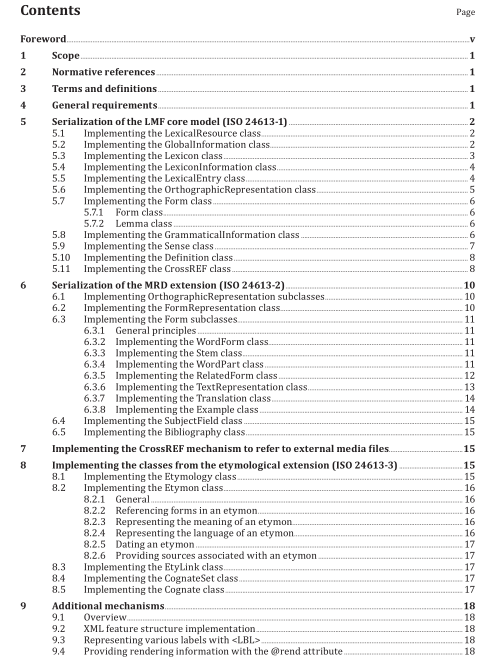ISO 24613-5:2022 pdf download.Language resource management — Lexical markup framework (LMF) — Part 5: Lexical base exchange (LBX) serialization
This document describes the serialization of the lexical markup framework (LMF) model defined as an extensible markup language (XML) model derived from the language base exchange (LBX) schema and compliant with the W3C XML schema. This serialization covers the classes, data categories, and mechanisms of ISO 24613-1 (core model), ISO 24613-2 (machine-readable dictionary (MRD) model),and ISO 24613-3 (etymological extension).
2 Normative references
The following documents are referred to in the text in such a way that some or all of their content constitutes requirements of this document. For dated references, only the edition cited applies. For undated references, the latest edition of the referenced document (including any amendments) applies.
ISO 15924, Information and documentation — Codes for the representation of names of scripts
ISO 24613-1, Language resource management — Lexical markup framework (LMF) — Part 1: Core model ISO 24613-2, Language resource management — Lexical markup framework (LMF) — Part 2: Machinereadable dictionary (MRD) model
ISO 24613-3, Language resource management — Lexical markup framework (LMF) — Part 3: Etymological extension
IETF BCP 47. Tags for Identifying Languages. Phillips, A., Davis, M. (eds.), September 2009. Best Current Practice. Available from: https:// tools .ietf .org/ html/ bcp47
W3C. Extensible Markup Language (XML) 1.1 (Second Edition). W3C Recommendation 16 August
2006, edited in place 29 September 2006. Available from: https:// www .w3 .org/ TR/ 2006/ REC -xml11 -20060816/
3? Terms? and? definitions
For the purposes of this document, the terms and definitions given in ISO 24613-1 and ISO 24613-3 apply.
ISO and IEC maintain terminology databases for use in standardization at the following addresses:
— ISO Online browsing platform: available at https:// www .iso .org/ obp
— IEC Electropedia: available at https:// www .electropedia .org/
4 General requirements
This document aims at providing constructs for each LMF class from ISO 24613-1 (core model),ISO 24613-2 (MRD extension), and ISO 24613-3 (etymological extension). It requires compliance with ISO 24613-1, ISO 24613-2, and ISO 24613-3 when implementing data categories referred to in the respective parts, and compliance with the W3C XML Schema 1.1 for representing structured information in XML. LBX extends the original models by means of data category selections and precise value lists, the creation of new subclasses and the definition of new constraints. In addition, this document complies with the cardinalities expressed in ISO 24613-1, ISO 24613-2, and ISO 24613-3. The LBX serialization is richer in detail than LMF, in order to meet specific design objectives. Still, this document does not elaborate on the metadata aspects from LMF, since the LBX schema is by essence much richer for the representation of all the aspects related to the creation, content, versioning and database implementation of lexical content at large. Occasionally, slightly equivalent constructs to explicit requirements from the LMF standard are mentioned. The XML examples in this document are simplified by omitting namespaces. Except where otherwise stated, it is assumed that XML elements belong to the LBX namespace and that the examples lie within the scope of the following XML namespace declaration:
xmlns=”http:// www .LexicalBaseExchange .org/ 2021/ schema”
Besides, datatypes in this document are defined in compliance to the XML Schema Part 2
recommendation. The “xs:” prefix corresponds to the following namespace:
http:// www .w3 .org/ 2001/ XMLSchema
5 Serialization of the LMF core model (ISO 24613-1)
5.1 Implementing the LexicalResource class
The LexicalResource class shall be implemented in LBX by means of the <LexicalResource> element (see Table 1), which groups together one to many lexicons in a single collection. This level may be
omitted in cases where the lexical resource contains only one lexicon so that the resource starts directly with the lexicon level. In cases where a lexical resource contains a large number of lexicons or several very large lexicons, the lexicon (XML document) can reference a virtual lexical resource using a @lexicalResourceID in the <Lexicon> element and optionally the <LexicalEntry> element (see 5.5).ISO 24613-5 pdf download.ISO 24613-5 pdf download
